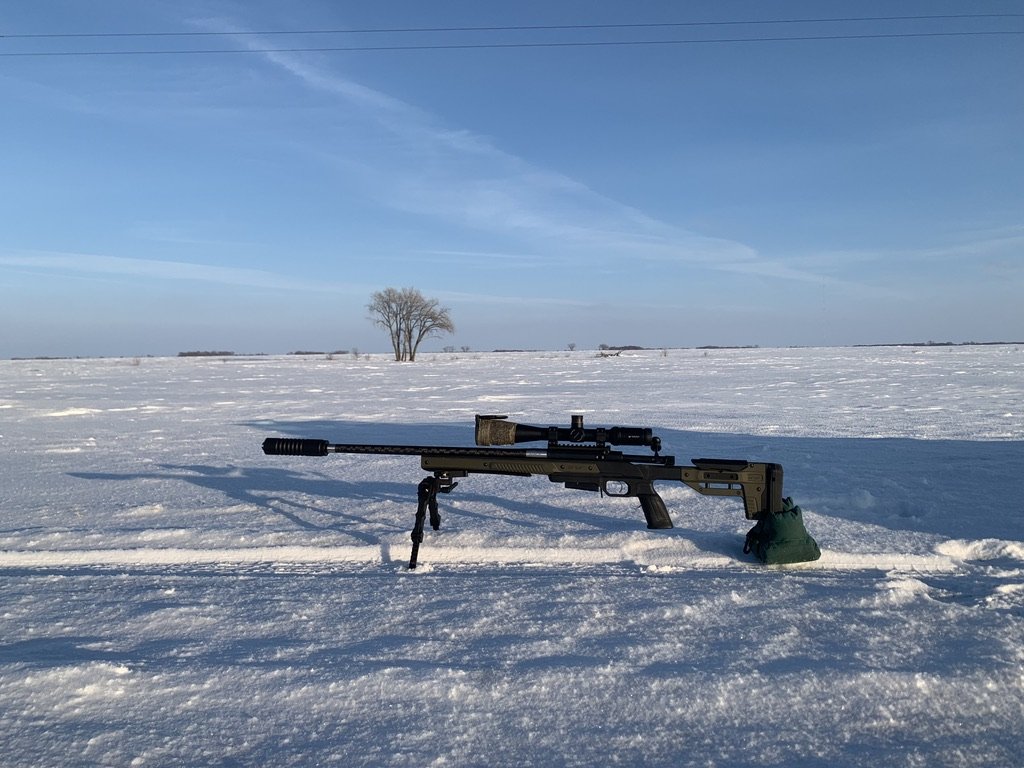The Cost of Keeping Quiet
By Les Voth
Suppressors cost a lot more than their sticker price. It can cost you a tank of gas to get pictures and fingerprints. You need to research the dealer you’re buying/transferring through. The government demands $200 per device - and an approval period of up to a year and a half. Then your barrel needs the threads necessary for attaching the dream.
What’s the dream? Hearing friendly shooting, of course.
The concussion of a center-fire rifle, a shotgun, a rim-fire rifle, or any handgun, can simply put shooters off of shooting. Complaining neighbors, curiosity seekers seeking out the source of the noise, and even the quiet courtesy of the enthusiast can keep trigger fingers from being exercised. Suppressors bring the noise levels to a place where noise-sensitive shooters can attain a level of comfort and fun found nowhere else in the sport.
Even though I’d never owned a suppressor, I’ve had a few attached to my rifles over the last few years. Friends and salespeople have handed various “cans” to me during shooting outings, imploring me to “be polite.”
The most used rifle sported a 27" Krieger Remington Varmint weight barrel, chambered in 6.5 CM. It was easy to determine which suppressors were most effective, lightest, etc., but the one that made the biggest impression was a full stainless steel beast that was almost as heavy as my whole rifle! That put me off SS as a building material - period!
If you’ve ever seen the flex of a pencil barrel with any can on it and been impressed, that piece of perforated railroad track would put a buggy whip to shame.
So began my intermittent hunt for the perfect - for me - rifle suppressor.
Aluminum(Al) had to be lighter. Titanium(Ti) certainly was. Rationally, or not, I thought Ti was the coolest idea, thinking back on my "Stainless experience.” But it was sure pricey! Light, though . . .
A friend acquired a Ti suppressor from a company named AB Suppressor. It quickly became his favorite. Weight, design, and dimension converted him, as his “daily shooter” rides with him everywhere he goes.
I took notice. I was impressed with all that impressed my friend.
The company’s history as a turbocharger manufacturer did, too. A turbocharger spins at 250,000 to 350,000 for its lifetime - hopefully for years of reliable service. If someone is capable of manufacturing something that operates with that kind of speed, precision and reliability, then transfer that knowledge into the production of a suppressor - I’m interested!
Recently, AB Suppressor came out with a new product - The Warthog - made of Stainless Steel(!) that I was able to test.
What was the test? Well . . . Noise, of course.
I also wanted to know how my zero would change from a muzzle brake on a 22" Carbon Wrapped Bartlein barrel chambered in 6.5 SAUM, on one rifle. The other rifle was a 6mmBR with a 27.5" Bartlein #3 barrel. The 6mmBR was threaded but had never worn a muzzle device. My interest here was to see if the POI would shift going from naked, to the addition of 11.7 ounces.
Was the test fun? (I was actually asked this as I sat in front of the three-bar radiant fire, later that day.) Testing day was -9 degrees Fahrenheit with a 13 mile per hour breeze wafting in from about 9:30. It was one of those things you just “do”.
Doesn’t matter how you feel, it matters what you do.
The point of aim shift on the SAUM flinging 135 ATips at about 3000 FPS was about 1.25” higher than with the brake, at 100 yards.
Sound with the Warthog on the SAUM was more than tolerable. If I was hunting with it I would leave the muffs at home. However, if I was killin’ rocks with prejudice at distance, using the “fire for effect” approach - I would add the muffs, but wouldn’t screw them too tight.
Was the combination of the SAUM and the Stainless Warthog cumbersome? Not at all. With the direct thread mount enveloping the muzzle threads, the rifle only grew about 6" in length. So, it was like having a 28" barrel, total.
Weight-wise the combination wasn’t hefty, most likely because of the Carbon Wrapped barrel. The balance required no noticeable issue.
Switching the Warthog to the BR’s barrel was a simple matter of casually leaning against the car so the -30+ windchilling wind didn’t cause me to lose my footing on the ice. Screw it offa one and onta another, and done.
This combination had a different effect. First of all the 27.5" #3 Bartlein grew to about 33ish inches. That’s a lot of barrel! I was almost ready to be annoyed/disappointed with the overall length.
Of course, it was my fault, but still . . .
As with the first test involving the SAUM, I first shot at 100 yards to check my zero. It hit right inside the little box I’d drawn on the paper, at home in the warm house.
‘K. Now let’s warm this can up and see if it walks.” Talking to yourself in the cold helps you check wind speed and it’s breezerly direction - just follow the breath!
Shifting to my steel setup across from the snow covered evergreen at 410 yards, I touched it off. Psssft/clang!
A few more of those and I checked back to the 100 yard paper and the POI was right alongside the first, the cold bore shot. So, back to killin’ the steel at 410 until I got nervous about getting the car started again, cuz I couldn’t feel my fingers to find the key.
With the 6mmBR I was shooting 105s pushed by 30 grains of Varget. That’s not much powder no matter what it’s pushing. Little charges equate to little noises - especially with a Warthog attached.
I’ve changed my mind about Stainless Steel as a building material for suppressors. They can be made light.
Yes, there was a slight POI shift with the SAUM, but without adjusting my scope I was still banging steel at 410 yards. A little math and compensation and the twain shall meet. If I had a dedicated can for that rifle I’d dial it in for sure. But this was only a test. It passed the test.
With no POI shift with the 6mmBR, I would still dedicate a Warthog to that long barrel. The shooting experience regardless of the weather was definitely enhanced by suppressing this rifle. If it’d been 10 degrees warmer I might still be out there shooting . . .
Would I buy one? Absolutely! In fact, I’d buy two! Stainless steel is less expensive to build with, so Warthogs are less expensive to own than suppressors built of Titanium. The way these Warthogs are made makes them lighter than any other Stainless steel constructed cans, too.
Yup. I had fun. Yup. I like them.





